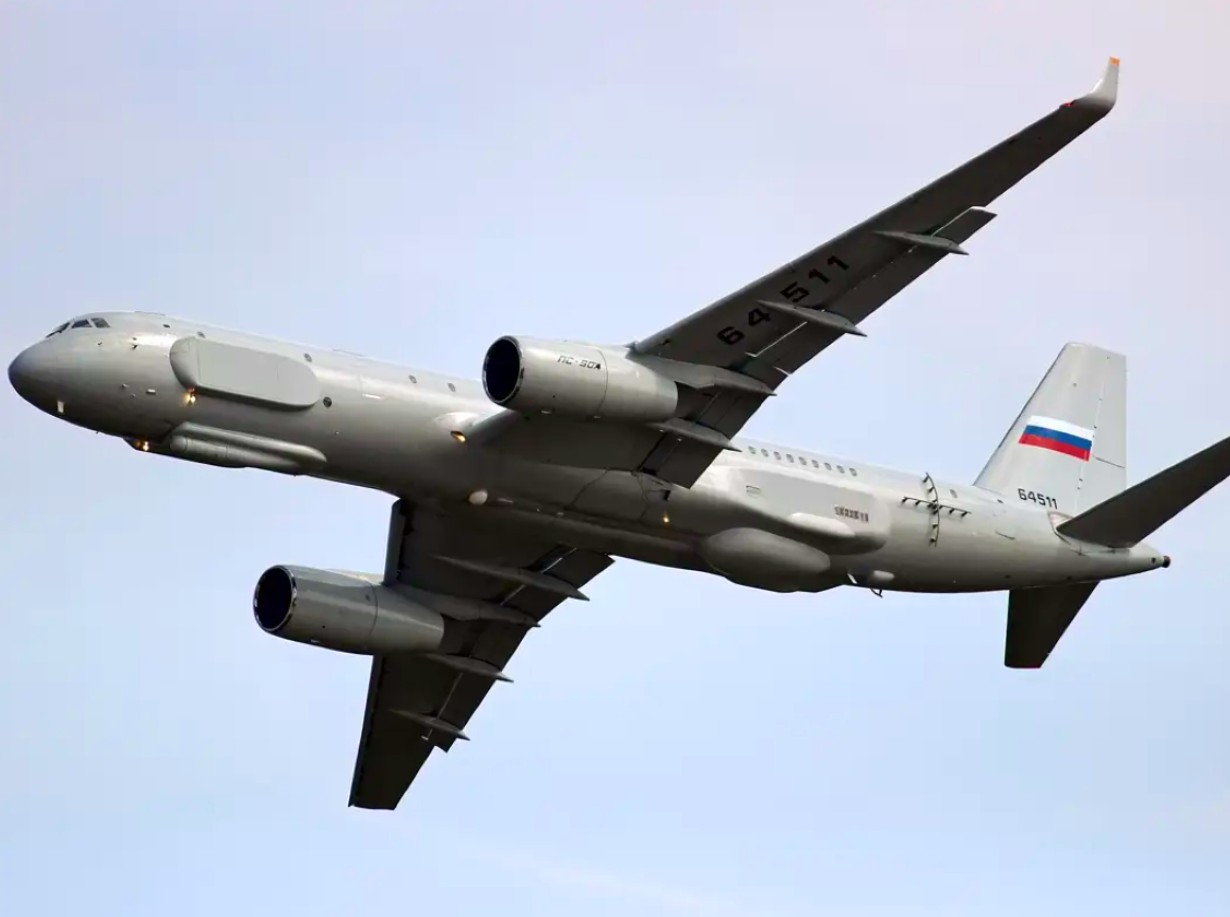Russia’s reconnaissance plane for ‘officially spying’ on the United States as a part of a long-running military de-escalation treaty was scaled up and heavily upgraded and used to track and locate Ukrainian military installations, RIA Novosti reported.
Stealth-On-Stealth! Russian Forces Are Deploying The New ‘X-69’ Stealthy Cruise Missile On Su-57 Fighters
Turkey Confirms Interest In Eurofighter Typhoons; Says Negotiating With Europe Amid F-16 Uncertainty
Following the tensions beginning from then-President Donald Trump’s administration, the US and Russia exited the treaty. The Tupolev 214R is one of the two such planes used by Russia, with their previous iteration being the Tu-214ON.
“This aircraft is capable of detecting and promptly transmitting to ground command posts the coordinates and type of military facilities of various classes, including radar stations, command posts, communication centers, columns of military equipment, and others,” the RIA Novosti report said.

What Is The Open Skies Treaty?
The Open Skies Treaty was initially signed in 1992 but only entered into force in January 2002. Since then, a total of 35 countries have joined. Open Skies allows inspection flights over member states’ territory under certain technical and flight conditions, the primary one being having monitors from the surveilled country.
This allows for data on military forces and activities and ensures there is no hostile mobilization that might escalate to war between bigger militaries. The treaty limits the resolution of the reconnaissance sensors that can be utilized.
In August 2002, Russia conducted the first observation flight under the treaty. The United States, under former President Donald Trump, left Open Skies in November 2020, while Russia exited the treaty by mid-2021.
This allowed Russia to convert the Tu-214ON into the far more advanced Tu-214R – an eventuality considered amongst US military circles.
A former Russian Aerospace Forces (VKS) pilot involved in electronic warfare said in a post on Russian social media that the US exit from Open Skies was an “unwitting gift.”
“Russia now has one of the world’s most advanced reconnaissance planes, which even the US is well aware of. The flexibility this allows Russia to conduct even larger scale operations, when it has not even employed its full force in Ukraine is tremendous (sic),” the retired aviator said. An advantage with the two Tu-214s is that given their young age of only 8-10 years, their airframe has not undergone wear and tear, with their service life still long.
Russia’s ‘Super Airborne Spy’
The Tu-214R is a relatively new aircraft, designed in 2009. The aircraft was officially accepted into service in 2012, and its first test flight was in 2011.
The plane was a joint project between the Tupolev Public Joint Stock Company (PJSC), the JSC Vega Radio Engineering Corporation, various enterprises of the United Instrument Manufacturing Corporation (UMIC), the Roscosmos State Corporation, and the Almaz-Antey Corporation.
Based on the 2014 commercial transport aircraft, it is configured to carry the MRK-411 multi-band radar, Electronic Intelligence (ELINT) sensors, side-looking synthetic aperture radar (SAR), and other Signals Intelligence (SIGINT) and Communications Intelligence (COMINT) devices.
These intercept signals emitted by enemy systems, radar, aircraft, ground vehicles, mobile phones, and radios that help build an Electronic Order of Battle (EOB) of the enemy forces. This includes their location and the possible nature of the equipment.
They can track current activity and subsequent moves by eavesdropping on their radio communication. The aircraft can activate its systems in active and passive modes, which helps hide its location.
It can conduct overhead surveillance on the ground at a distance of up to 250 kilometers and from a height of 9-12 kilometers, peer deep behind enemy lines while being safely within its own territory, protected by its own fighter aircraft and air defense systems.
Its signature weapon is said to be the Ground Penetrating Radar (GPR), which helps see objects covered by sand, trees, and even slightly underground – usually the safest mode of concealment.
A powerful electro-optical imaging system complements this that can capture real-time, high-resolution images of the terrain and the visible and infrared ranges. Information gathered through the SIGINT antenna, fitted on the side fuselage aft of the wing, is dispatched to other assets via an extensive communications suite, including a dorsal-mounted satellite communication antenna.
For self-defense, it uses thermal and radar decoy dispensers mounted on both sides of the fuselage aft of the wing. The planes are primarily operated by Russia’s military intelligence, popularly known as the GRU of the Russian General Staff.
The aircraft performs regular missions and patrols in sensitive zones like the coast of Japan, the Ukrainian border, and Syria.
On December 17, 2012, the Japanese Air Self-Defense Force (JASDF) intercepted a Tu-214R, particularly the one with the serial number RA-64511. The aircraft had flown from Khabarovsk towards Hokkaido island, then again turned west and returned to Khabarovsk via the coast of North Korea.
- The author can be reached at satamp@gmail.com
- Follow EurAsian Times on Google News